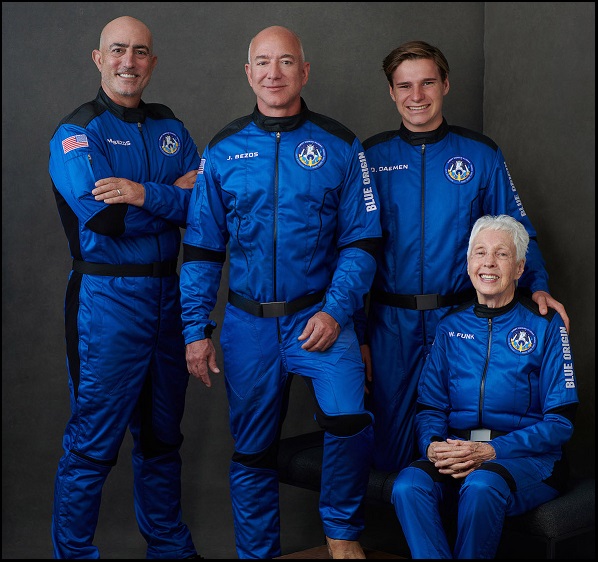The successful space flight of Amazon founder Jeff Bezos – which he completed this week after years of development by his space venture Blue Origin – has validated the use of private-sector Agile design principles that have turned conventional, risk-paralysed government programs on their heads.
Previous rockets have traditionally been designed for just one use – an expensive and time-consuming strategy that had kept the cost of space launches eye-wateringly high.
By contrast, Blue Origin’s rockets – the 20m-long New Shepard that carried Bezos this week is the precursor to a 100m New Glenn cargo ship with 35 times as much thrust – were developed using cloud-based digital design tools that Ariane Cornell, director of astronaut and orbital sales with Blue Origin, enabled the company’s focus on “operational reusability”.
“Nobody before has had to think about how you build a rocket that can be easily refurbished,” she told a recent AWS Innovation Day forum.

The Blue Origin New Shepard crew: [L to R] Mark Bezos, 53; Jeff Bezos, 57; Oliver Daemen, 18; and Wally Funk, 82.
After lifting Bezos past the 100km Kármán line into space, New Shepard will be checked and any degraded components – for example, thermal protection or a crush-prone portion of the landing legs – replaced.
The New Shephard vehicle was tested 15 times before Blue Origin decided it was ready to put humans onboard.
“Flying a rocket is one thing,” Cornell said, “but the moment you put a person onboard, you’d better understand that vehicle through and through.”
Try, then try again
Development of New Shepard and New Glenn – as well as the Blue Moon lunar lander – has been driven by data-intensive design process supporting the firm’s motto of moving ‘step by step, ferociously’.
The evolving ships are visualised using virtual reality and augmented reality based on cloud-hosted data that does for today’s astronautical engineers what the slide rule did for those in the early days of the space race.
Engineers can walk through digital models of the rockets as they evolve, iteratively tweaking physical design and, for example, evaluating access to ensure that all parts are accessible by maintenance teams.
“Modelling is absolutely critical to what we do,” Cornell said.
Data-driven, iterative digital design has been transformative for the aeronautical engineering sector, helping agile teams quickly build and test all manner of innovative craft.
“In the last half century since the Concorde was designed, we’ve completely changed the fundamental technologies we use to design and build airplanes,” said Blake Scholl, founder and CEO of airplane designer Boom Supersonic – the spiritual successor to the Concorde decommissioned in 2003.
“We’ve gone from developing with slide rules and drafting paper and wind tunnels, to computer-aided design and computer simulation-driven optimisation.”
Boom Supersonic – which recently signed a deal with Delta Airlines to adopt its Overture for transcontinental flights twice as fast as conventional planes – relies on ‘virtual wind tunnels’ that model the flow of air past the in-development vehicle in minute detail.
“Traditionally, developers had to build their own compute clusters in-house, and ultimately were limited in the simulations they can run,” Scholl said. “Running in the cloud, we’re able to tap into virtually unlimited compute capacity when we need it.”
“When we’ve got a key question, or a bunch of different designs that we want to try, we can suddenly build one of the world’s largest supercomputers; run hundreds of wind-tunnel tests in parallel; and pick the winners.”
Ready access to such power lets Blue Boom Supersonic’s designers run simulations six times faster in the cloud than they could by trying to manage their own systems – “and that,” Scholl said, “means Boom can accomplish with a tiny team of 150 people, what used to take hundreds or thousands of employees at a much larger company.”
Validated also by Sir Richard Branson’s Virgin Galactic launch earlier this month – and by the ongoing success of Elon Musk-driven SpaceX – it is the exploding private space industry’s adherence to successful Agile methodologies that will continue to accelerate its departure from conventional and expensive space manufacturing.
“Reducing the cost of access to space means that a lot more people, and a lot more organisations, are going to be able to access the unique environment and unique resources of space,” Cornell explained, highlighting long-term visions of long-term space colonies built using the same approach.
“It’s a truly grand vision that takes really big thinkers, and constant innovation. It may sound fantastic now, but give it some time and that is a possible future reality – but you’re not going to be able to do it unless you lower the cost of access to space.”










